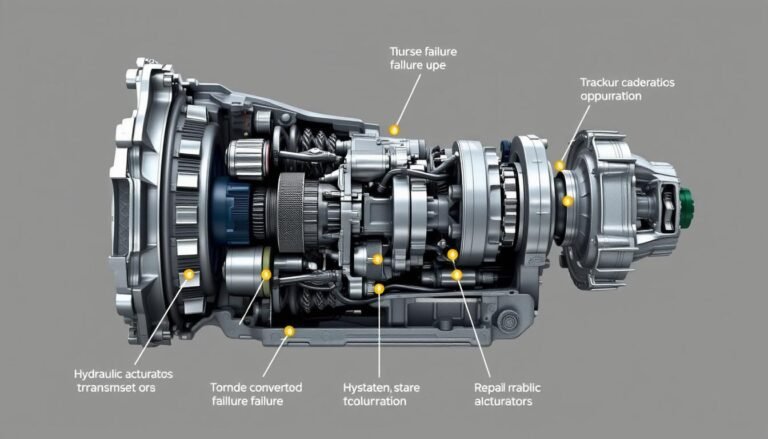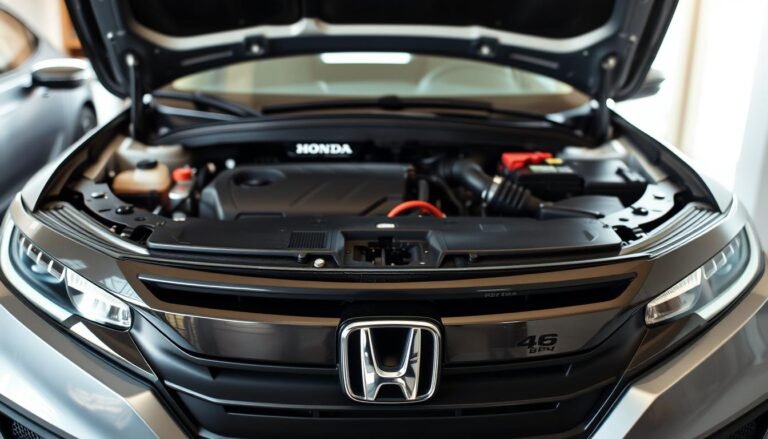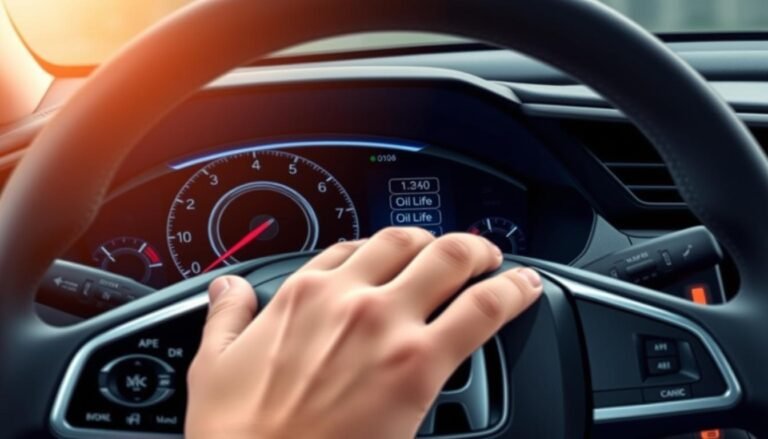VSA Light On Honda: Causes & Quick Fixes
The VSA light on Honda tells you about your car’s stability systems. It lights up to indicate the vehicle’s stability control is working, keeping you safe.
Knowing what this light means helps you fix stability problems with your car. The VSA light might blink or stay on, showing different states of the system.
This guide will help you figure out why the VSA light comes on and how to fix it fast. We’ll first look at the VSA system and what the light means.
You’ll learn common reasons why the light turns on and how to troubleshoot. This includes checking tire pressure and fluids.
With these tips, you’ll know when you can fix an issue yourself or need a professional. Keeping on top of your car’s condition ensures a safer drive.
Now, let’s make sure your Honda is stable and trustworthy on the road.
What’s The VSA System in Honda Vehicles?
The Honda VSA system, known as Vehicle Stability Assist, greatly improves driving safety. It keeps the vehicle stable by checking drive conditions and data.
The system spots if the car is losing grip or starting to skid by watching wheel speed and steering. When something risky is detected, the VSA system steps in.
It tweaks brake pressure and might change engine power. This helps keep the car in control, especially on slippery roads or during sudden turns.
Honda first put this system in the 2008 Accord, showing their commitment to safety tech. Knowing what the VSA light means is crucial for Honda drivers.
This light warns you when the system is working or if there’s a problem. Getting to know this feature helps keep your car safe and running smoothly.
What Does The VSA Light Indicate?
The Honda VSA light is very important for your vehicle’s safety. It shows how the Vehicle Stability Assist (VSA) system is doing.
When you see the honda vsa light on, it means the system is working as it should. This light comes on to keep the car stable in different situations.
If the VSA light starts blinking, it is helping you keep control of the car. This might happen if the road is slippery or you’re making a sharp turn.
But, if the light doesn’t go off after you start the car, there might be a problem with the VSA system. This should be checked out right away.
Knowing what these light signals mean is very important. It helps you act fast to fix any issues with the VSA system. This keeps you safe while driving.
If the problem doesn’t go away, you might need to do a honda vsa light reset. After that, a professional should check your car to make sure everything is okay.

Different Manifestations of The VSA Light
The VSA light shows up in a few different ways, each telling you something important as the driver.
If the honda vsa warning light stays on, it means the system is ready to help. It’s ready to keep the car stable in tough situations.
If you see the honda vsa light flashing, it’s actually working to keep the car steady. This happens in slick conditions or when you make sudden moves.
It means the system is controlling wheel slip. When the VSA light doesn’t go off, even after you restart the car, there could be a problem.
This needs a check-up right away to keep your car safe and reliable. Knowing what the VSA light means helps you react the right way.

Common Reasons For The VSA Light On Honda
The honda vsa light on can occur due to several common triggers. Understanding these can help you diagnose the issue effectively.
One frequent reason is the malfunction of wheel-speed sensors. These sensors monitor your vehicle’s speed and when they fail, they can trigger the VSA light.
Low brake fluid levels also contribute to the illumination of this warning light. If your brake fluid is too low, it can cause a loss in braking efficiency, impacting your vehicle stability.
Another common trigger is problems with the steering angle sensor. This sensor helps determine the angle of the steering wheel and communicates with the VSA system.
If it’s malfunctioning, the VSA light may turn on. Additionally, a fault within the vehicle stability assist system itself could be the culprit.
Regular examination of these components is crucial for understanding the state of your VSA system and addressing any arising issues.

Beyond The Basics: Less Common Causes of VSA Light Illumination
When your Honda’s VSA light comes on, you might first think of usual problems. But, there are other reasons for the VSA light to turn on that are less known.
Knowing these reasons helps you deal better with the VSA light. Sometimes, electromagnetic waves can mess with the Honda VSA system.
This can mix up the signals in the system, causing the VSA light to come on. Another less common issue is when the VSA pump motor breaks.
This motor is vital for the VSA system to work right. If it fails, the VSA light might turn on without a good reason.
Putting on a spare tire the wrong way can also cause the VSA light to light up. If the spare tire is not the right type for your car, the VSA system might see something is off and warn you.
Likewise, if your car is too heavy or not loaded right, it can upset the car’s balance. This puts more work on the VSA system, making the light come on.
Learning about these unusual reasons for a VSA light can give you a better understanding.
This knowledge arms you with the confidence to solve these issues on your own.
VSA Light On Honda: Quick Troubleshooting Steps
Before you seek help for your Honda’s VSA light, try some easy troubleshooting steps. These steps could help you reset the VSA light and save money on repairs.
Start with simple checks to fix common causes of the VSA light turning on.
Checking Tire Pressure and Size
First, make sure all four tires have the right air pressure. They should match the manufacturer’s recommendations.
If the pressure is off, it could turn on the VSA light, which means there’s an issue. Also, check if your tires are the correct size.
The wrong size can affect how your car drives and impact the VSA system.
Inspecting Fluid Levels and Brake Components
Then, look at your car’s fluid levels, especially the brake fluid. If it’s low, the VSA light might come on to tell you there’s a problem.
Also check the brakes for any damage or wear. These checks are key in fixing VSA light issues early.

Professional Assistance: When To Seek Help
Knowing when to seek professional help with your Honda’s VSA system is key for safety. Trying to fix small issues yourself can work.
But, it is critical to know when the problem is bigger. If the VSA light stays on after simple checks, take it seriously.
Issues like uneven braking or traction problems need quick action. Knowing when to see a mechanic can save you both time and avoid more damage.
Qualified technicians have the right tools for Honda VSA system repairs. They can pinpoint what’s wrong quickly and fix it.
Driving Safety with The VSA Light On
When the Honda VSA warning light comes on, it means there’s a big safety concern. It tells you that driving with the VSA light on can make your car less stable and hard to control.
To keep safe, you should drive more carefully. This means slowing down a lot, leaving more room between you and the car in front, and avoiding sudden moves.
This careful way of driving lowers the risk of slipping, especially in bad weather like rain or snow.
By paying attention to the warning light, you can control your car better. You’ll also be able to deal with the problem causing the light to turn on.
Preventative Measures For a Healthy VSA System
Keeping your Honda VSA system in good shape is key for safe driving. It’s important to keep up with regular maintenance.
This prevents issues with the VSA light that could interrupt your drive. Taking care of the system before problems arise is a smart move.
Following the advised maintenance schedule from the manufacturer is crucial. This plan often includes checks on the system’s parts and making sure sensors work right.
Besides regular check-ups, you should do these things too:
- Monitor tire pressure and condition to ensure optimal traction.
- Drive cautiously in adverse weather conditions to enhance handling.
- Inspect brake fluid levels regularly to maintain system integrity.
Adding these steps to your car care routine shows you care about safety. Keeping up with Honda VSA system maintenance helps you drive with more confidence.
It makes it less likely for the VSA light to come on without warning.
Conclusion
The VSA light is more than a simple indicator. It’s a key part of your Honda’s stability and safety features.
Knowing about the VSA system helps you understand why the VSA light comes on. This is vital for fixing issues before they turn into bigger problems.
This guide taught you the reasons behind the VSA light’s activation. You also learned steps to figure out these issues on your own.
With these insights, you can confidently address VSA related issues. This ensures your Honda stays reliable for every journey.
Putting your safety and your Honda’s performance first helps you make smart choices for both. Knowing the VSA light’s role will make your driving better.
Be ahead of the curve. Use what you’ve learned about the Honda VSA light to keep your car safe and running well.
FAQs
Q: What does it mean when the Honda VSA light is on?
A: When the Honda VSA light is on, it means there might be a problem. It shows the Vehicle Stability Assist system might not work right or is helping with vehicle control.
Q: Why is the Honda VSA light blinking?
A: A blinking Honda VSA light shows the system is working to keep the vehicle stable. This happens mainly in tough driving situations.
Q: How can I reset the Honda VSA light?
A: To reset the Honda VSA light, turn off the car, wait a bit, then start it again. If the light stays on, you might need more checks.
Q: What are common causes for the Honda VSA warning light to activate?
A: Common causes are wheel-speed sensors not working, low brake fluid, and problems with the steering angle sensor.
Q: Can low tire pressure trigger the Honda VSA light?
A: Yes, low tire pressure can make the Honda VSA light turn on. Uneven tire pressures can mess with the car’s stability and activate the system.
Q: When should I consult a professional about the Honda VSA system?
A: Seek professional help if the VSA light keeps being on after you try fixing it or if the car’s braking or handling feels different.
Q: How can I prevent the VSA light from turning on?
A: Keep the tire pressure right, make sure the brake fluid is at the correct level, and follow the car’s maintenance plan to avoid the VSA light.
Q: What if the Honda VSA light stays on after restarting the vehicle?
A: If the VSA light doesn’t go off after restarting the car, it means there’s a serious issue. You should get the VSA system checked right away.







